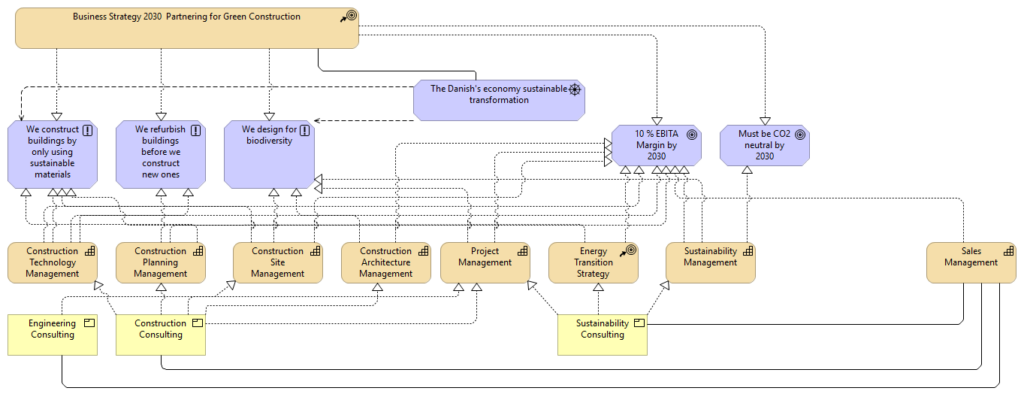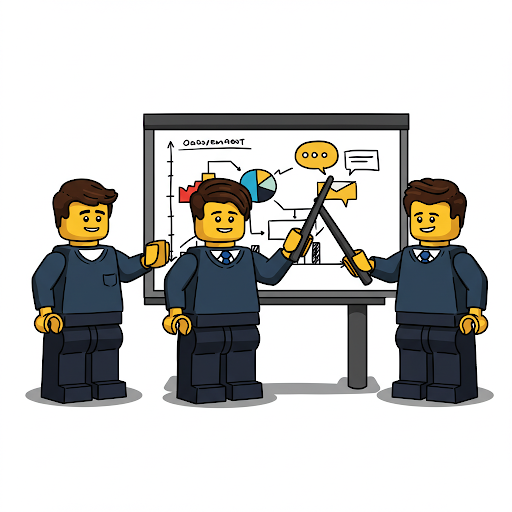The enterprise architect continued his work on sketching out the business strategy of the AEC-company. He decided to do so he could create a line of sight for the company’s CTO. The enterprise architect has begun mapping the business strategy to capabilities, principles, and the capabilities to products that are delivered by the AEC-company to its customers.
The purpose of having such an overview as part of having an enterprise architecture programme (Please note an enterprise architecture endeavor is not a project) is to provide the overview relevant stakeholders on what the consequences of changes will be. Examples of this could be changes to the business strategy, changes to the business functions (Structure), products, and lastly how this will impact the business applications and digital infrastructure.
The AEC-company provides three products for its customers:
- Engineering consulting.
- Construction consulting.
- Sustainability consulting.
Capabilities
Since the AEC-company for historic reasons primarily sells the construction consulting products that are delivered as services, most of the capabilities owned by the AEC-company have been set up to support that specific product originally.
- Construction Site Management.
- Construction Planning Management.
- Construction Architecture Management.
- Project Management.
- Construction Technology Management (A recently created capability to support SMART-buildings and SMART-city trends).
This also enforces a path dependency for the company, which means that adjustments and configurations will have to be done in order for the AEC-company to realise its business strategy. Construction of new buildings is one of the most CO2 emissions intensive activities that can take place, then the AEC-company will have to strengthen its existing capabilities and embed its existing practices from the sustainability management into the other capabilities as-well either as part of the business processes (Business practices).
The path dependency will impact the AEC-company’s ability to adapt technologies minded for other types of consulting services to enhance its capabilities, its competitive position, competitive advantages or product line. Potentially this can become a risk for the AEC-company if its executive management does not understand the potential problems of not being able to navigate changes.
The enterprise architect’s approach is to apply the top-down approach meaning that the line of sight must be based on the strategy elements (Course of action), drivers, goals, and products; which leads to the below illustration (Mapping):

A Capabilities-Based Strategy
The enterprise architect identifies that the AEC-company’s business strategy, Partnering for Green Construction, is reliant on a set of capabilities that provides strengths for the company and a set of capabilities that would need to be strengthened as part of the strategy period in order to ensure the completion of the strategy and its subsequent goals. One of many positive perspectives of approaching the business strategy from a capabilities-based perspective is that the capabilities can be used to identify areas that need improvements from four perspectives and each constitutes a value:
- People with their skillsets.
- Information technologies.
- Data as in datasets and data products available.
- Business processes and their states.
The enterprise architect can with the above in mind use the capabilities to map the gap(s) and what would be needed to fill the gap(s); however applying the capabilities-based approach also enables the governance related deliverables needed to produce a system landscape that provides the business and IT-stakeholders the intended overview and possibility to ensure alignment across business demands and IT. This would also provide significant value for the AEC-company’s CTO in the discussions with the business stakeholders on how to enhance the capabilities of the AEC-company.
The enterprise architect also realises by having this deliverable that enables the AEC-company to provide the foundational architectural services to support scenario planning and consequence planning; since there will be a trade off by each of the options that the executive management team will choose as part of the “Partnering for Green Construction”.
The line of Sight
The enterprise architect now has the ability to apply the level 3 depth of the relationships from the course of action element that represents the business strategy.


Leave a Reply